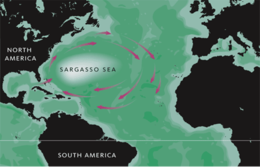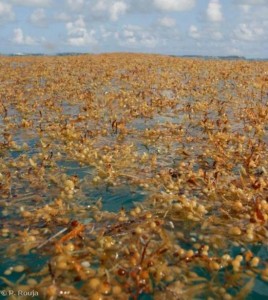The Sargasso Sea is a large region of rotation ocean currents located in the middle of the North Atlantic Ocean. It is bounded by the west by the Gulf Stream and on the North by the Altantic Current and on the east by the Canary Current and on the South by the North Atlantic Equatorial Current. So what does this have to do with Belize. Well if you have been here, you would notice all the seaweed known as sargassum on the shorelines. The Sargasso Sea is home to this seaweed, which floats in masses on the surface there.
The Sargasso Sea also plays a major role in the migration of the Loggerhead Sea Turtles that use the currents, such as the Gulf Stream to travel to the Sargasso Sea, where they use the sargassum as cover from predators until they are mature. The ability of a sea turtle to migrate hundreds (and occasionally thousands) of miles from its feeding ground to its nesting beach is one of the most remarkable acts in the animal kingdom. That adult females return faithfully to nest on the very beach where they were born makes the feat even more amazing. Research into where and how sea turtles migrate has been a focus of scientists for decades. We now know that sea turtles undergo migration throughout their lives, during its first critical 48 hours, a hatchling must travel from the beach to a place in the ocean where it is relatively safe from predators and where it can find food. Many hatchlings in the Caribbean make their way into Gulf stream currents, which are filled with floating sargassum weed. There the young turtles find an ample food supply and few predators. After several years of floating around the Atlantic, these young turtles are big enough to venture back into nearshore waters.
So, although this seaweed is a pain in the beach, we have to love it because we all like to go swim and dive with turtles in Belize. In the meantime, it is all along the shoreline and the Caye Caulker Village Council and beachfront residents are cleaning it up daily. When the Sargassum reaches the beaches it dies and some of the marine species that use it as protection do as well. A lots of happy birds. The smell is unpleasant and it makes it hard to enjoy a swim or relax by the beach and enjoy the not so fresh sea breeze. This year, there has been triple the amount that usually comes at this time of year, so what is causing this bloom? Some say global warming is causing the algea to multiply.










